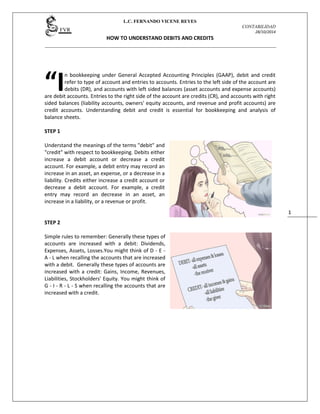
Credits and debits
- 1. L.C. FERNANDO VICENE REYES CONTABILIDAD 28/10/2014 HOW TO UNDERSTAND DEBITS AND CREDITS 1 n bookkeeping under General Accepted Accounting Principles (GAAP), debit and credit refer to type of account and entries to accounts. Entries to the left side of the account are debits (DR), and accounts with left sided balances (asset accounts and expense accounts) are debit accounts. Entries to the right side of the account are credits (CR), and accounts with right sided balances (liability accounts, owners' equity accounts, and revenue and profit accounts) are credit accounts. Understanding debit and credit is essential for bookkeeping and analysis of balance sheets. STEP 1 Understand the meanings of the terms "debit" and "credit" with respect to bookkeeping. Debits either increase a debit account or decrease a credit account. For example, a debit entry may record an increase in an asset, an expense, or a decrease in a liability. Credits either increase a credit account or decrease a debit account. For example, a credit entry may record an decrease in an asset, an increase in a liability, or a revenue or profit. STEP 2 Simple rules to remember: Generally these types of accounts are increased with a debit: Dividends, Expenses, Assets, Losses.You might think of D - E - A - L when recalling the accounts that are increased with a debit. Generally these types of accounts are increased with a credit: Gains, Income, Revenues, Liabilities, Stockholders' Equity. You might think of G - I - R - L - S when recalling the accounts that are increased with a credit. “I
- 2. L.C. FERNANDO VICENE REYES CONTABILIDAD 28/10/2014 HOW TO UNDERSTAND DEBITS AND CREDITS 2 STEP 3 Remember that the books must always be kept in balance so that every debit entry must be accompanied by a corresponding credit entry, and vice versa. This is the standard double-entry bookkeeping system. STEP 4 Set up the balance sheet with all debit accounts on the left and credit accounts on the right. For illustration, assume that ABC Company has $5000 cash, $7000 inventory, $3000 capital stock, and $9000 surplus. The balance sheet would be as follows: STEP 5 Set up the ledgers (the books for record-keeping) for each account. Place the debit balance on the left and the credit balance credit on the right. Remember that debit accounts have debit balances and credit accounts have credit balances. For our example, the ledgers would appear as follows: STEP 6 For each transaction, consider what is being exchanged for what, which debit account it affects and whether the effect is to increase or to decrease. Does it change the amount of cash, the amount of receivables, the inventory, amount of properties, or an expense? If the transaction increases a debit account, record a debit entry in that debit account, and simultaneously a credit entry in an appropriate credit account. If the transaction decreases a debit account, record a credit entry in that debit account, and
- 3. L.C. FERNANDO VICENE REYES CONTABILIDAD 28/10/2014 HOW TO UNDERSTAND DEBITS AND CREDITS 3 simultaneously a debit entry in an appropriate credit account. Suppose the company in our example has subsequently sold on credit $4000, which cost it $2800, and incurred various expenses totalling $500 paid in cash. The $4000 sold on credit increases Accounts Receivables, and is therefore a debit entry. For simplicity, let us log all profit and loss as credit or debit in the Surplus account. Thus, the debit entry of $4000 under Receivables would have a corresponding credit entry of $4000 under Surplus. The cost of goods sold of $2800 decreases the inventory, and is therefore a credit entry. It will have a corresponding $2800 debit entry from Surplus. The $500 expenses paid in cash decreases Cash account, and is therefore a credit entry. It will have a corresponding $500 debit entry from Surplus. These entries are recorded as follows. STEP 7 Calculate the ending balance in each account and update the balance sheet. The example given would be as follows: STEP 8 Check that the books are balanced again.” WEB: http://www.wikihow.com/Understand-Debits-and-Credits TEXT IS COMPLETELY THE, ABOVE, WEBSITE
